Image credits:
M. Kvick et al., KTH Sweden;
S. Dearing et al., CIFI Italy;
C. Marchioli et al., UNIUD Italy.
Venue
Palazzo Antonini Mangilli del Torso is one of the most imposing and beutiful in Udine: the building goes back to 1577, as shown by the stone in the internal courtyard, which also commemorates the name of the owner at that time.
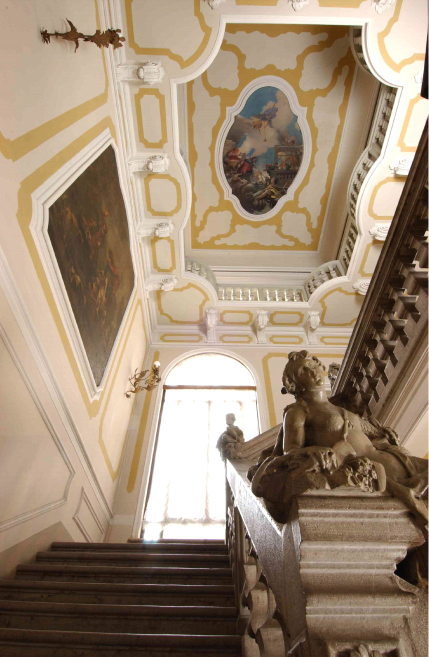 A view of the ceiling above the staircase |
It was finally completed, as far the facade is concerned, a little before 1680: Fabio della Forza wrote in that year: “Daniele built many buildings in the Grazzano district, which have now grown to a double palace”.
In the facade, which is made pleasant to the eye by a play of light and dark, by the armony of the decorative parts and the balance of the structural parts, there are two entrance gates: a large one for coaches and a smaller one for pedestrians. There are pleasant windows with arched iron bars in the Venetian style on the ground floor, three mullioned windows on the first floor which have overhanging balconies, as have the four windows which open onto the sides. The gable is connected to the lower level by means of baroque volutes. At the centre of the building, level with the third floor windows, one can see the family’s coat of arms which are partly hidden by the shadow of the widely overhanging eaves, in the traditional Friuli way.
The house has remained virtually unchanged in its facade since that time, as is shown by a nineteenth century litograph by G.B. Ceccini. It is made up of four parts surrounding a central courtyard. Inside it has been almost completely re-structured by the architect Andrea Scala in 1847 who re-divided some of the rooms in a way which was very common at the time: it tended to make those large spaces which had been created with different criteria more suitable for family purposes.
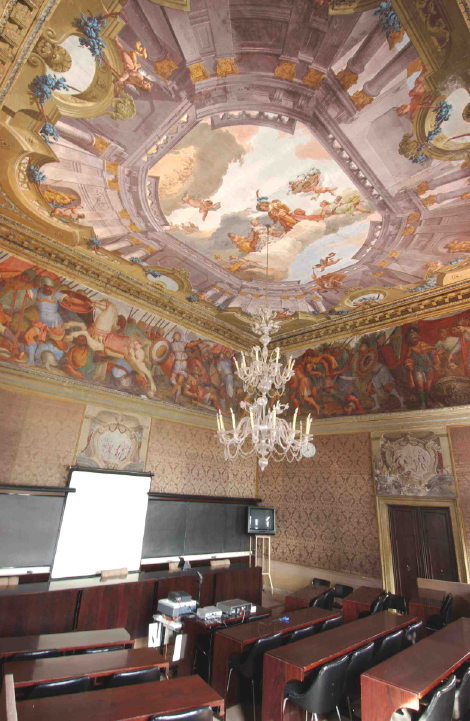 View of the Conference Room |
More recently (1924), Count del Torso, when he bought the house, hade it re-adapted to suit his own tastes; this is especially clear in the hall. The monumental staircase, which he wanted installed, is not an original but comes from the Palazzo de Portis in Cividale. It shows a tipically Friulan taste, both in its use of dark Piacenza stone and the massive structure of the pillars, which can also be seen in other buildings in Udine, as for example Palazzo Gorgo-Maniago.
The canvas painting with the ” Allegory of the arts” which decorates the vault was commissioned by the Count from the painter H.Stubysen who tried to give the composition an eighteenth century air, with hints of the tradition of great Venetian painting.
The scene is contained in an ovate with a strong stucco frame. It is executed with propriety both in the composition, with daring foreshortenings, and the fresh luminous colouring . The beautiful bench with a headrest , which can be found in the hall, is an original of the house. These benches are a not infrequent decoration in the noble houses in Udine, though many of them have been destroyed. The two paintings which decorates the hall are also original, although they are not exactly in a perfect state of preservation. One is a pleasant canvas with Apollo and Daphne, the other a noteworthy “Scene from a Boar Hunt” . This latter is extremely lively in narrative, with fiercely snarling dogs and a fiery steed in the foreground. Tiozzo has attributed these works to Andrea Urbani.
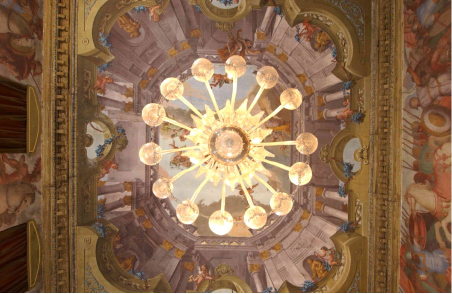 The Conference Room : frescoes by Andrea Urbani |
On the first floor , which has no great reception room but all the space befitting a noble family’s residence, some of the rooms are distinguished by their elegant ornaments. In the “Rectors’ Room ” there is a painting, “Comtemplation”, a pleasant work by the still little know painter from Ruscedo, Jacopo D’Andrea (1819–1906) and also a nineteenth century fresco above the fireplace ( Apollo playing ). The ” Yellow Room ” is decorated with light stucco squares on the walls and ceiling. It has also four ovates with eighteenth century paintings of exellent workmanship. They are ” The Sacrifice of Isaac ”, ” Abraham and the Angel “and two landscape with figures. Although they are almost miniatures in size, it is still possible to appreciate their spatial openings, a finesse of touch, certain precious modulations of colours.
The nearby room with golden stuccoes and the portraits of the Counts del Torso leads us into the “Conference Room”, where the ceiling is completely covered with frescoes. Domenico Urbani, in the booklet which more than a century ago he dedicated to his great-grandfather Andrea, recalls that the latter painted “the ceiling of the hall in marquis Mangilli’s house in borgo Grazzano in Udine, and the two ceilingsof the chapels in the Cathedral”. The latter can be dated from 1742 to 1749.
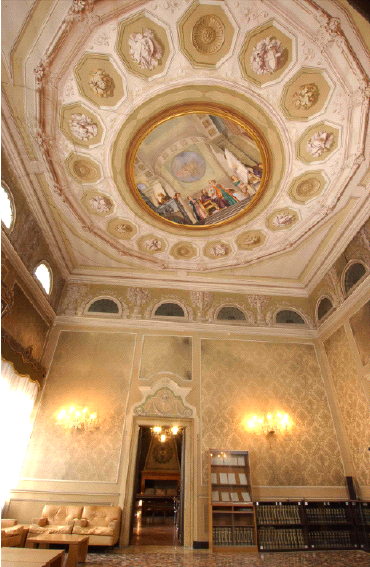 Fresco by Andrea Chiarottini in the corridor |
However there are many other pictorial works: his long and fertile activity, characterized by not infrequent changes of style, was continued by his son Marino who, at the beginning of the nineteenth century, carried out frescoes for the Palazzo Caiselli and Fisturalio Plateo.
The ceiling of the Palazzo Mangilli was formerly attributed to Giuseppe Morelli. However it was first dated by Tiozzo who estimated that it was done in about 1750, that is, immediately after he had decorated the Cathedral. A date between 1750 and 1760 certainly seems plausible: the scenographic effect seems to foreshadows the style he adopted a few years later in St.Teonisto in Treviso. This scenographic effect, especially in the figurative part, recall themes which are common to the graet Venetian painters of the eighteenth century. The architectural composition is noteworthy : it simulates a structure with an arcade of Corinthian columns, parastates, cornices, the whole animated by plaesant figures of cherubs bathed in light , holding garlands of deep blue flowers against a sky furrowed by clouds where the Mangilli family stands out. Two pleasant frescoes fanlights are also attributed to Urbani ; they are in black and white, with lively little figures in elegant frames.
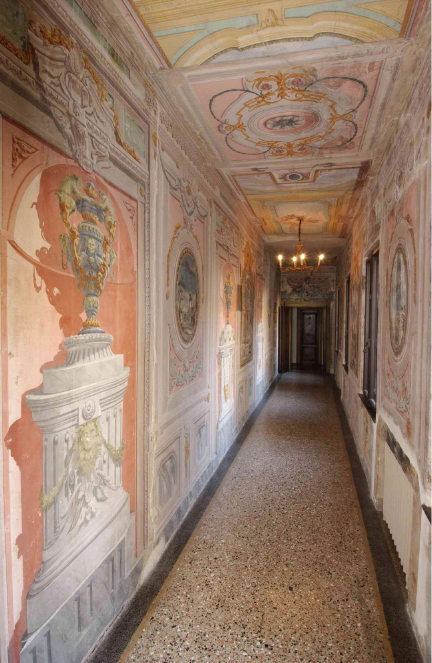 Fresco by Andrea Chiarottini |
Next to the “Conference Room “there is the “Sofa Room”, formerly the ball room designed by the architect Andrea Scala in 1851 and immediately after decorated with pleasant ornamentation by Giovanni Pontoni, one of the many excellent craftsmen of the nioneteenth century. the frescoes on the central circle of the ceiling were done by Domenico Fabris from Osoppo. It is a conventional painting which does nothing to increase the reputation of the author, though it demonstrates his undoubted technical ability. At the end of the nineteenth century, the room was embellished by the two statues of Minisini which are now in the courtyard.
The nearby dining room, with a beamed ceiling and woodcovereed walls where the coats of arms of the noble families of Friuli are painted, from 1355 (de Ottanicis ) to 1914 (Deciani), was done at the express wish of the Count del Torso soon after he purchased the house in1924.
In some of the bedrooms two eighteenth century wardrobes excite admiration. One of them has four doors, is L-shaped and decorated with ribbons and garlands of flowers , all painted very professionally. The frescoes in the narrow corridor which joins the two parts of the building have been attributed to Andrea Urbani.
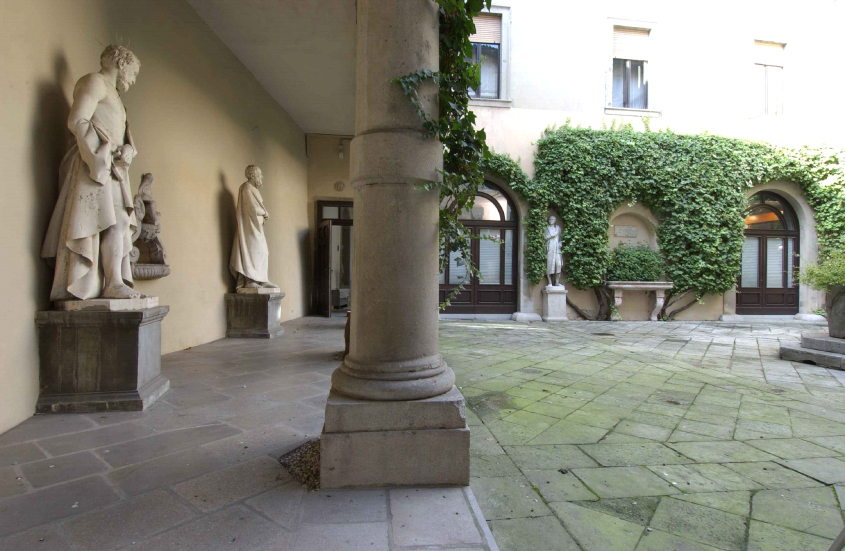 CISM Internal Court |
On the walls there are two alternating motifs: a vase on a pedestral between artificial niches; and ovates containing delicious views of imaginary scenes and solemn classical architecture. In the small internal courtyard, some precious sculptures are preserved. There are two finely modelled statues by Luigi Minisini representing, as is written on the scroll which they hold in their hands, the two Greek Philosophers Heraclitos( “every thing from fire ”) and Democritos ( “every thing from the atom” ). There is a fine stone seventeenth century lavabo, some Romans statues all tondo, two beautiful bas reliefs, again from the Roman age, including one by C.Clodio, a masterpiece of efficient portrayal.
The park outside is rendered particulary fine by its longstemmed plants and its very size. Inside there is a massive construction which would appear at first sight to date from the Renaissance; an open,cube-shaped loggia, where the vault is decorated with grotesque paintings which are good in ideas but poor in execution .
